- HTML Comments Tutorial | Convert Comments into HTML Codes
- Data Structure and Algorithms Tutorial | Ultimate Guide to Learn
- Gradle Tutorial | For Beginners [ STEP-IN ]
- Encapsulation In Java | Complete Tutorial With Examples
- What is Release Management? | A Comprehensive Tutorial for Beginners
- OOPs Concepts in Java | Learn from Basics with Examples
- The Top Basic Tools of Quality Tutorial | The Ultimate Guide
- Set Environment for C# – Learn How to Setup through this Tutorial
- C# Vs Java Tutorial | Overview and Key Difference
- List of IDEs to run C# Programs | Tutorial for Learning Path
- C Sharp Variables and Constants | The Ultimate Guide
- Unsafe Code in C-Sharp Tutorial | Everything You Need to Know
- Type Conversion Method in C# | A Complete Tutorial
- What Is Synchronization in c# Tutorial | The BEST Step-By-Step Guide
- Understanding Structures in C# | Learn in 1 Day FREE Tutorial
- Strings – C# Tutorial | A Definitive Programming Guide
- Static Keyword in C# Tutorial | Learn with Examples
- Stack Collection in C# Tutorial | A Definitive Guide for Beginners
- C# Sorted List Tutorial with Examples | Learn in 1 Day FREE
- C# Serialization Tutorial | Ultimate Guide to Learn [BEST & NEW]
- Regular Expression in C# Tutorial | Everything You Need to Know
- What is Reflection in C#? | Learn Now Tutorial
- Queue Collection in C# Tutorial | A Definitive Guide
- Properties in C# | The complete Tutorial
- C# Preprocessor Directives Tutorial | Learn in 1 Day FREE
- Polymorphism C# Tutorial | The Ultimate Guide
- C# Operators Tutorial | Learn Arithmetic, Comparison, Logical Concepts
- Namespaces – The complete C# Tutorial
- Multithreading in C# Tutorial | Learn With Examples and Advantages
- Methods – C# Tutorial | A Complete Programming Guide
- Linked List Implementation in C# Tutorial | Ultimate Guide to Learn [UPDATED]
- Introduction to C# Tutorial | Guide for Beginners
- What is Interface in C# | A Defined Free Tutorial
- C# Inheritance Tutorial | A Complete Free Tutorial
- Indexers in C# Tutorial | A Complete Programming Guide
- HashSet Collection in C# Tutorial | Complete Guide Tutorial For Free
- Generics in C# Tutorial | Learn Generic Classes and Methods
- Creating Your First C# Program Tutorial | Learn in 1 Day
- Basics of File Handling in C# Tutorial | The Ultimate Guide
- C# Exception Handling Tutorial | Learn with Best Practices
- Events – C# Tutorial | A Complete Programming Guide
- C# Enumerations Type Tutorial | Learn Everything about Enum
- Dictionary Collection in C# | Ultimate Guide to Learn [NEW & UPDATED]
- Delegates – C# Programming Guide | The Ultimate Guide for Beginners
- Understanding Decision Making Statements in C# | Learn Now Tutorial
- Classes and Objects – C# Fundamentals Tutorial
- C# BitArray Collection Tutorial | Learn in 1 Day FREE
- Attributes in C# Tutorial | Learn to work with attributes in C#
- C# Array Tutorial | Create, Declare, Initialize
- ArrayList Collection on in C# | A Complete tutorial For Beginners
- Anonymous Methods and Lambdas – C# Tutorial | A Complete Guide
- Abstraction in C# Tutorial – Learn the Abstract class and Interface
- Game Development using Unity 3D Tutorial | Ultimate Guide to Learn [UPDATED]
- C++ Reference Tutorial | A Comprehensive Guide for Beginners
- PHP vs Python | Which Is Better For Web Development
- C++ Constructors Tutorial: Types and Copy Constructors
- JavaScript Arrays Tutorial | Complete Beginner’s Guide
- What Is Maven | Maven Tutorial For Beginners
- Spring Tutorial | Perfect Guide for Beginners
- React Hooks Tutorial for Beginners | Ultimate Guide to Learn
- Python for Data Science Tutorial | Quickstart : A Complete Guide
- What is Golang? : A tutorial for beginners | Get started
- Hibernate Validator Tutorial | Learn in 1 Day FREE
- Postman Tutorial for Beginners: API Testing using Postman | A Complete Guide
- Akka Tutorial
- J2EE | Web Development Tutorial for Beginners
- Scala Exception Handling Tutorial | Learn in 1 Day [ STEP-IN ]
- Web development Tutorial
- Visual Studio Tutorial
- PyGame Tutorial
- Python Anaconda Tutorial
- Python Scikit-Learn Cheat Sheet Tutorial
- Mean Stack Tutorial
- Python Requests Tutorial
- Advanced Java Tutorial
- Spring Boot Microservices Tutorial
- Java Servlets Tutorial
- How to Install Pycharm
- Pycharm Tutorial
- Python Version Tutorial
- Python strings
- How to Download Python
- C Data Types Tutorial
- arrays in python
- Python While Loop Tutorial
- JAVA Tutorial
- Loops In C Tutorial
- Java File I/O Tutorial
- Variables in Python Tutorial
- Python Tutorial
- Python Pandas Cheat Sheet Tutorial
- Data Structures Cheat Sheet with Python Tutorial
- Python Tuples Tutorial
- Python If Else Statements Tutorial
- Python Functions Tutorial
- HTML Comments Tutorial | Convert Comments into HTML Codes
- Data Structure and Algorithms Tutorial | Ultimate Guide to Learn
- Gradle Tutorial | For Beginners [ STEP-IN ]
- Encapsulation In Java | Complete Tutorial With Examples
- What is Release Management? | A Comprehensive Tutorial for Beginners
- OOPs Concepts in Java | Learn from Basics with Examples
- The Top Basic Tools of Quality Tutorial | The Ultimate Guide
- Set Environment for C# – Learn How to Setup through this Tutorial
- C# Vs Java Tutorial | Overview and Key Difference
- List of IDEs to run C# Programs | Tutorial for Learning Path
- C Sharp Variables and Constants | The Ultimate Guide
- Unsafe Code in C-Sharp Tutorial | Everything You Need to Know
- Type Conversion Method in C# | A Complete Tutorial
- What Is Synchronization in c# Tutorial | The BEST Step-By-Step Guide
- Understanding Structures in C# | Learn in 1 Day FREE Tutorial
- Strings – C# Tutorial | A Definitive Programming Guide
- Static Keyword in C# Tutorial | Learn with Examples
- Stack Collection in C# Tutorial | A Definitive Guide for Beginners
- C# Sorted List Tutorial with Examples | Learn in 1 Day FREE
- C# Serialization Tutorial | Ultimate Guide to Learn [BEST & NEW]
- Regular Expression in C# Tutorial | Everything You Need to Know
- What is Reflection in C#? | Learn Now Tutorial
- Queue Collection in C# Tutorial | A Definitive Guide
- Properties in C# | The complete Tutorial
- C# Preprocessor Directives Tutorial | Learn in 1 Day FREE
- Polymorphism C# Tutorial | The Ultimate Guide
- C# Operators Tutorial | Learn Arithmetic, Comparison, Logical Concepts
- Namespaces – The complete C# Tutorial
- Multithreading in C# Tutorial | Learn With Examples and Advantages
- Methods – C# Tutorial | A Complete Programming Guide
- Linked List Implementation in C# Tutorial | Ultimate Guide to Learn [UPDATED]
- Introduction to C# Tutorial | Guide for Beginners
- What is Interface in C# | A Defined Free Tutorial
- C# Inheritance Tutorial | A Complete Free Tutorial
- Indexers in C# Tutorial | A Complete Programming Guide
- HashSet Collection in C# Tutorial | Complete Guide Tutorial For Free
- Generics in C# Tutorial | Learn Generic Classes and Methods
- Creating Your First C# Program Tutorial | Learn in 1 Day
- Basics of File Handling in C# Tutorial | The Ultimate Guide
- C# Exception Handling Tutorial | Learn with Best Practices
- Events – C# Tutorial | A Complete Programming Guide
- C# Enumerations Type Tutorial | Learn Everything about Enum
- Dictionary Collection in C# | Ultimate Guide to Learn [NEW & UPDATED]
- Delegates – C# Programming Guide | The Ultimate Guide for Beginners
- Understanding Decision Making Statements in C# | Learn Now Tutorial
- Classes and Objects – C# Fundamentals Tutorial
- C# BitArray Collection Tutorial | Learn in 1 Day FREE
- Attributes in C# Tutorial | Learn to work with attributes in C#
- C# Array Tutorial | Create, Declare, Initialize
- ArrayList Collection on in C# | A Complete tutorial For Beginners
- Anonymous Methods and Lambdas – C# Tutorial | A Complete Guide
- Abstraction in C# Tutorial – Learn the Abstract class and Interface
- Game Development using Unity 3D Tutorial | Ultimate Guide to Learn [UPDATED]
- C++ Reference Tutorial | A Comprehensive Guide for Beginners
- PHP vs Python | Which Is Better For Web Development
- C++ Constructors Tutorial: Types and Copy Constructors
- JavaScript Arrays Tutorial | Complete Beginner’s Guide
- What Is Maven | Maven Tutorial For Beginners
- Spring Tutorial | Perfect Guide for Beginners
- React Hooks Tutorial for Beginners | Ultimate Guide to Learn
- Python for Data Science Tutorial | Quickstart : A Complete Guide
- What is Golang? : A tutorial for beginners | Get started
- Hibernate Validator Tutorial | Learn in 1 Day FREE
- Postman Tutorial for Beginners: API Testing using Postman | A Complete Guide
- Akka Tutorial
- J2EE | Web Development Tutorial for Beginners
- Scala Exception Handling Tutorial | Learn in 1 Day [ STEP-IN ]
- Web development Tutorial
- Visual Studio Tutorial
- PyGame Tutorial
- Python Anaconda Tutorial
- Python Scikit-Learn Cheat Sheet Tutorial
- Mean Stack Tutorial
- Python Requests Tutorial
- Advanced Java Tutorial
- Spring Boot Microservices Tutorial
- Java Servlets Tutorial
- How to Install Pycharm
- Pycharm Tutorial
- Python Version Tutorial
- Python strings
- How to Download Python
- C Data Types Tutorial
- arrays in python
- Python While Loop Tutorial
- JAVA Tutorial
- Loops In C Tutorial
- Java File I/O Tutorial
- Variables in Python Tutorial
- Python Tutorial
- Python Pandas Cheat Sheet Tutorial
- Data Structures Cheat Sheet with Python Tutorial
- Python Tuples Tutorial
- Python If Else Statements Tutorial
- Python Functions Tutorial
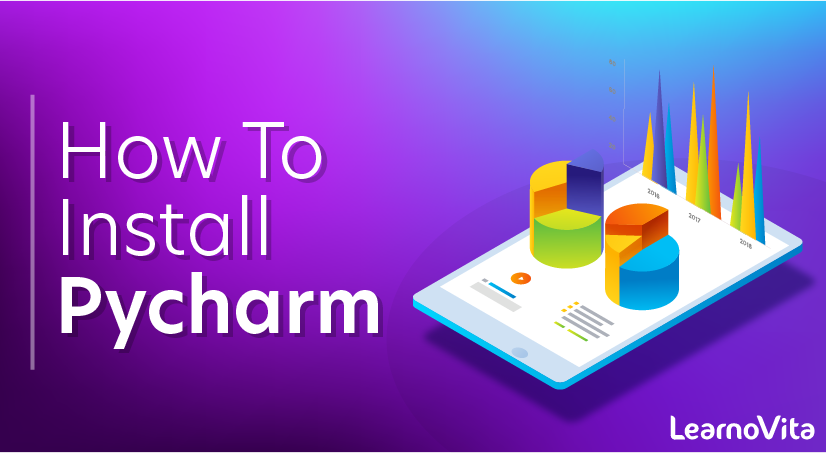
How to Install Pycharm
Last updated on 10th Oct 2020, Blog, Software Engineering, Tutorials
PyCharm is one of the most popular Python IDEs. There is a multitude of reasons for this, including the fact that it is developed by JetBrains, the developer behind the popular IntelliJ IDEA IDE that is one of the big 3 of Java IDEs and the “smartest JavaScript IDE” WebStorm. Having the support for web development by leveraging Django is yet another credible reason.
There are a galore of factors that make PyCharm one of the most complete and comprehensive integrated development environments for working with the Python programming language.
Before proceeding further into exploring the know-how of PyCharm i.e., features, installation, and pros & cons, let’s first get a brief introduction to PyCharm.
Subscribe For Free Demo
Error: Contact form not found.
What is PyCharm?
Available as a cross-platform application, PyCharm is compatible with Linux, macOS, and Windows platforms. Sitting gracefully among the best Python IDEs, PyCharm provides support for both Python 2 (2.7) and Python 3 (3.5 and above) versions.
PyCharm comes with a plethora of modules, packages, and tools to hasten Python development while cutting-down the effort required to do the same to a great extent, simultaneously. Further, PyCharm can be customized as per the development requirements, and personal preferences call for. It was released to the public for the very first time back in February of 2010. In addition to offering code analysis, PyCharm features:
- A graphical debugger
- An integrated unit tester
- Integration support for version control systems (VCSs)
- Support for data science with Anaconda
What is PyCharm used for?
The main reason Pycharm for the creation of this IDE was for Python programming, and to operate across multiple platforms like Windows, Linux, and macOS. The IDE comprises code analysis tools, debugger, testing tools, and also version control options. It also assists developers in building Python plugins with the help of various APIs available. The IDE allows us to work with several databases directly without getting it integrated with other tools. Although it is specially designed for Python, HTML, CSS, and Javascript files can also be created with this IDE. It also comes with a beautiful user interface that can be customized according to the needs using plugins.
What is an IDE?
PyCharm is an extremely popular Python IDE. An Integrated Development Environment or IDE features a code editor and a compiler for writing and compiling programs in one or many programming languages.
Furthermore, an IDE comes with a galore of features that facilitate comprehensive software development. As an IDE allocates different colors to different programming entities, typically known as syntax highlighting, it becomes more accessible to:
- Differentiate between various programming entities, such as a class and a function, and to spot them.
- Look for the wrong keywords.
- Read and comprehend the code.
Most IDEs feature an auto-complete feature that produces suggestions when writing code. This makes writing code more efficient, quick, and less prone to errors and typos. Other standard features offered by a modern IDE are:
- Project editor window for efficiently managing and organizing files necessary for a program/project.
- Inspecting the output of the code written using the output window
- Suggestions for resolving errors and warnings
- A range of modules and packages readily available at a single place
PyCharm Pricing Model
PyCharm is offered in three variants:
- A freemium version dubbed The Community Edition available under the Apache License.
- A commercial version labeled Professional Edition available under a proprietary license.
- A free-to-use educational version dubbed the Edu Edition, aimed for students and professionals interested in learning Python, available under the Apache License.
Features of PyCharm
1. Intelligent Code Editor
PyCharm comes with a smart code editor that facilitates writing high-quality Python code. It offers an enhanced level of code comprehension and readability by means of distinct color schemes for keywords, classes, and functions, i.e., syntax and error highlighting.
In addition to offering the smart code completion feature, the code editor generates instructions for completing the current code. Identifying errors and issues is much more comfortable, along with linter integration and quick fixes.
2. Availability of Integration Tools
PyCharm provides support for integrating a range of tools. These tools vary from helping in enhancing the code productivity to facilitate dealing with data science projects. Some of the most essential integration tools available for PyCharm include:
- Anaconda – A free and open-source Python distribution geared towards scientific computing with simplified package management and deployment.
- IPython – A robust command shell for interactive computing.
- Kite – An AI-powered autocomplete plugin.
- Pylint – A source-code, bug, and quality checker.
- pytest – A framework for writing small tests for Python code.
- WakaTime – A developer dashboard with productivity metrics and automatic time tracking
3. Data Science and Machine Learning [Professional Edition Only]
PyCharm comes with support for scientific libraries, such as Matplotlib and SciPy, to help Python developers accomplish data science and machine learning projects.
4. Google App Engine [Professional Edition Only]
Google App Engine, or directly App Engine, is a PaaS and cloud computing platform targeted towards developing and hosting web applications. It offers automatic scaling for web applications. The professional edition of PyCharm provides support for Google App Engine.
5. Integrated Debugging and Testing
An IDE comes with support for debugging and testing programs. To accomplish the same, PyCharm features an integrated Python debugger and integrated unit testing with line-by-line code coverage.
6. Multi-technology Development [Professional Edition Only]
Python developers can also use PyCharm for creating web applications. As such, the Python IDE provides support for popular web technologies, including CoffeeScript, CSS, HTML, JavaScript, TypeScript. Additionally, it also includes support for Cython, template languages, and SQL.
Live editing is also available in PyCharm, i.e., developers can create/modify a web page while pushing it live simultaneously. Hence, changes can be followed directly on a web browser. Building web applications using AngularJS or NodeJS is also available.
7. Project and Code Navigation
The code navigation feature makes it much easier for developers to navigate to a class, function, or file. It also helps in significantly cutting-down effort and time required to edit and enhance the Python code. File structure views and specialized project views are readily available.
The lens mode allows a developer to inspect and debug the entire Python source code thoroughly. With code navigation, locating an element, variable, etc. is done in almost no time. Developers can quickly jump between classes, files, and methods.
8. Refactoring
The refactoring feature in PyCharm helps in improving the internal structure of a Python program without affecting the external performance of the same. Making changes to both local and global variables is efficient and fast.
The extract method is also there to split up extended classes and functions. Other useful code refactoring features include:
- Introduce constant
- Introduce variable
- Pull up
- Push down
- Rename
9. Remote Development
PyCharm allows running, debugging, testing, and deploying applications on remote hosts or virtual machines. For the purpose, the Python IDE offers:
- An integrated SSH terminal
- Docker and Vagrant integration
- Remote interpreters
10. Support for Popular Python Web Frameworks [Professional Edition Only]
PyCharm lets developers leverage Django in their Python development projects. The Python IDE offers the autocomplete feature and generates suggestions for Django.
Debugging code written using Django is also available. PyCharm also provides support for other popular Python frameworks, namely Flask, Pyramid, and web2py.
11. Version Control Systems (VCSs) Integration
In its simplicity, a version control system (VCS) keeps track of the changes made to files, applications, and other sources of information. It can be considered as a database of changes.
PyCharm provides a unified user interface for CVS, Git, Mercurial, Perforce, and Subversion.
STAGE 1: Installing Python
Before installing the Pycharm IDE, we must first install Python.
Step 1: Download the Python, click here.
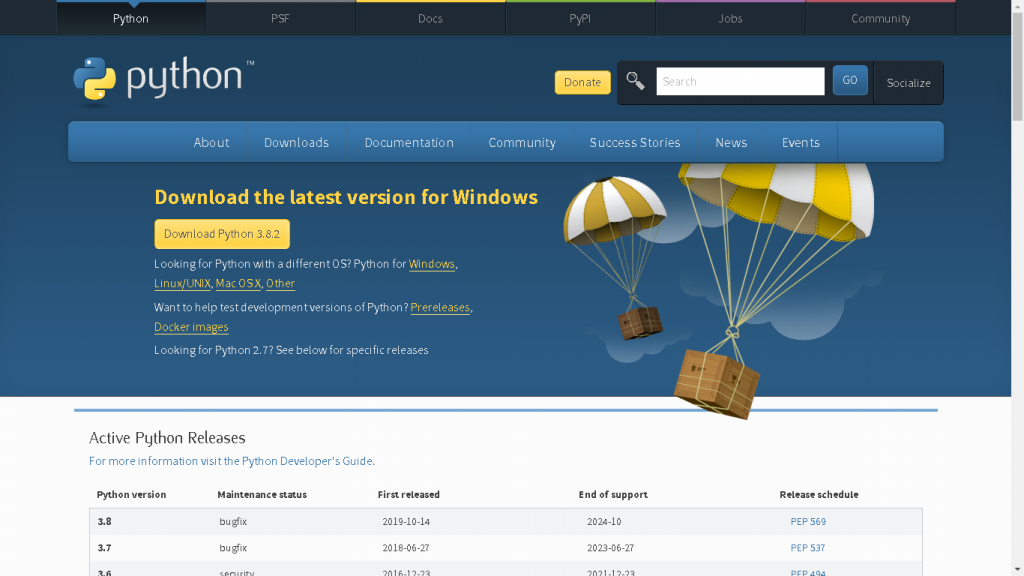
Click “Download Python 3.8.2”
Step 2: After downloading is complete, run the Python.exe. Then click on “Install Now”.
Step 3: After the installing is complete, Now click on “Close”.
STAGE 2: Installing Pycharm
Step 1: We have to download Pycharm IDE first, click here to download it. Then click the “DOWNLOAD” link under the Community Section if you want the free version.
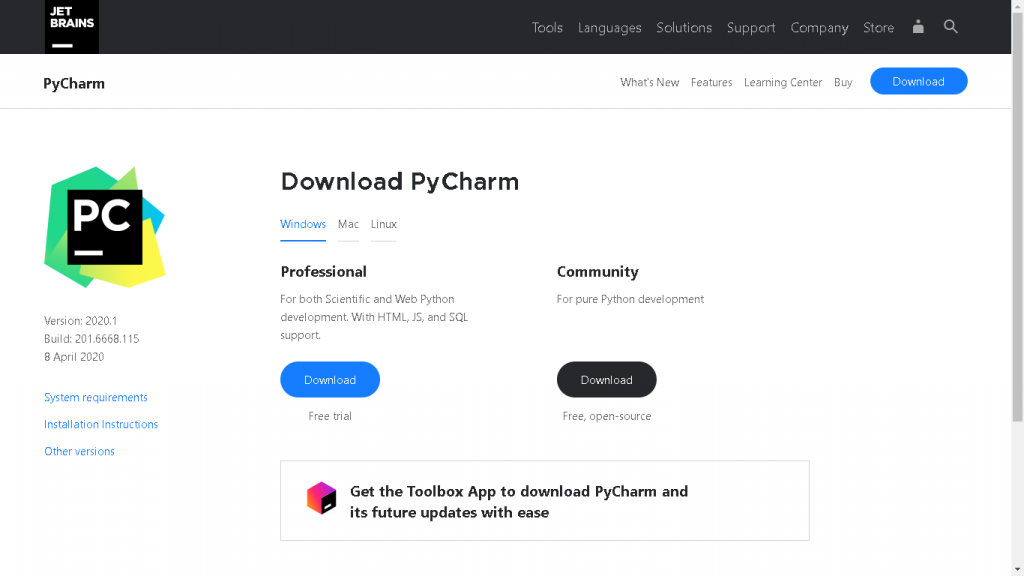
Step 2: After the Pycharm was downloaded successfully, run the PyCharm.exe. On the setup wizard, click “Next” and so on until the install process runs.
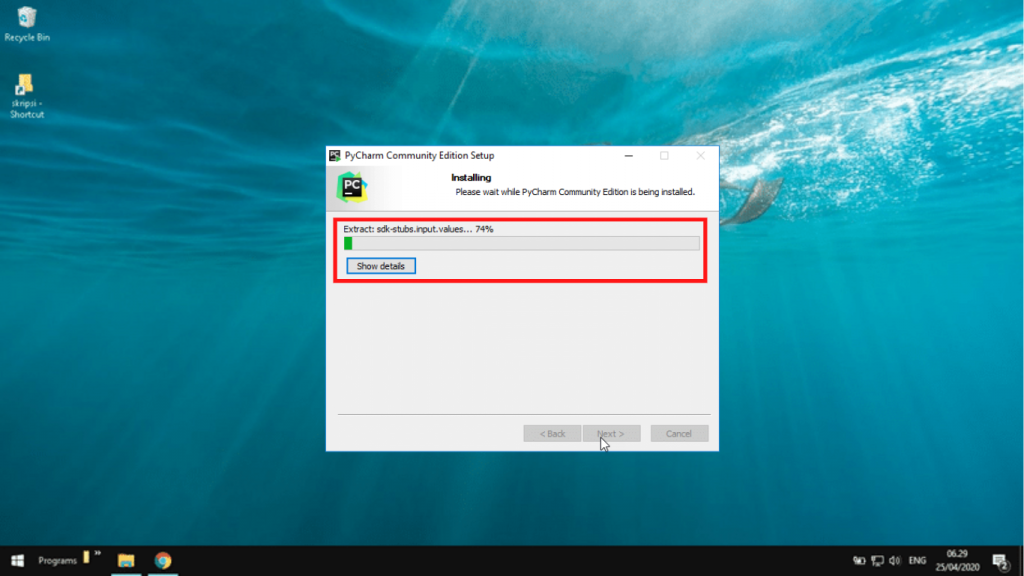
Step 3: Once the installation finished, you should receive a message screen that PyCharm is installed. If you want to go ahead and run it, click the “Run PyCharm Community Edition” box first and click “Finish”.
Congratulations! Pycharm IDE is ready to use.
STAGE 3: Create the project and set the virtual environment
Step1: Click “Create New Project”
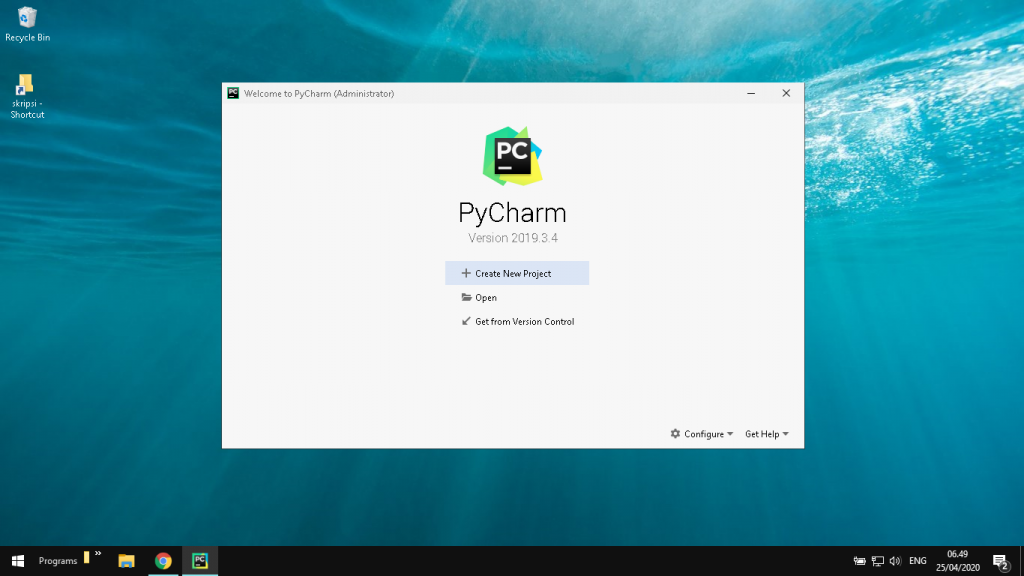
Step 2: Set the directory and name the project. Here, the project name is “First Project” in the “D:\Python” directory. Then click “Create”.
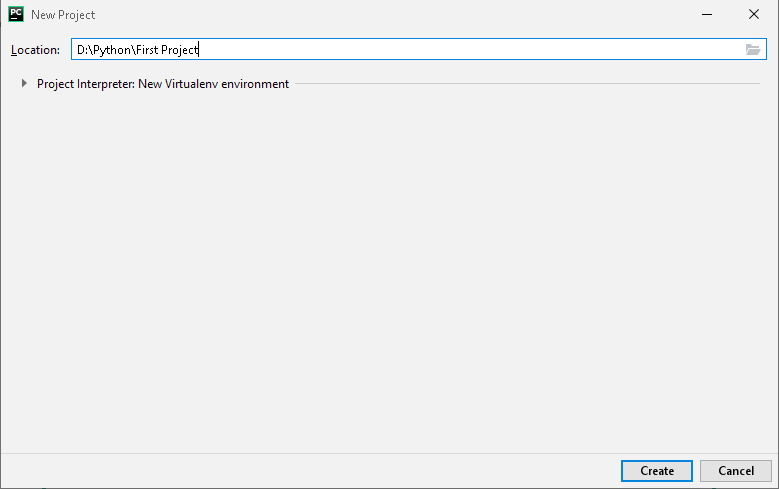
Step 3: Go to setting. Click “File”, then click “Setting”.
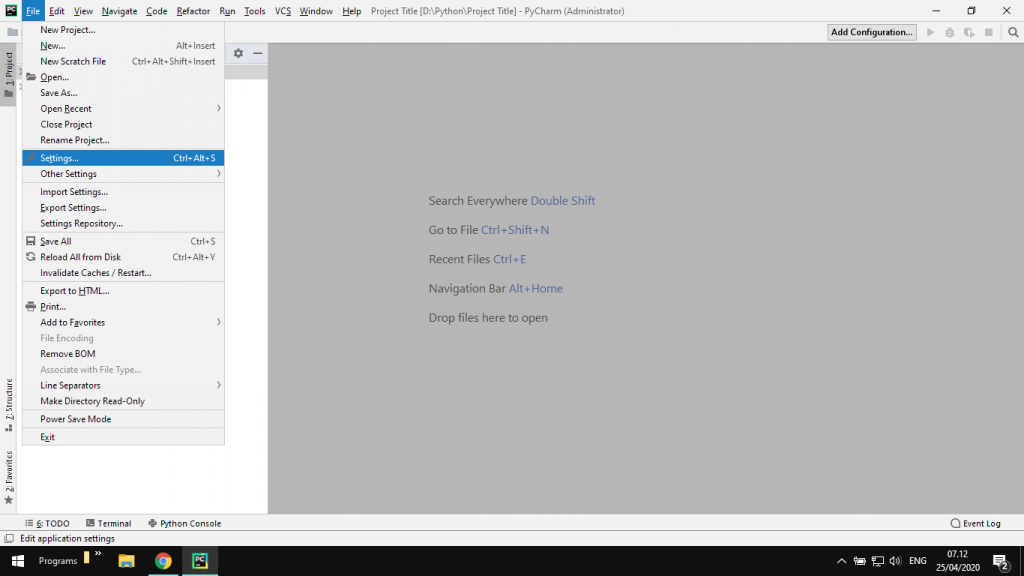
Step 5: Set the virtual environment. Click “Project Interpreter”, then “setting icon” and then click “Add”.
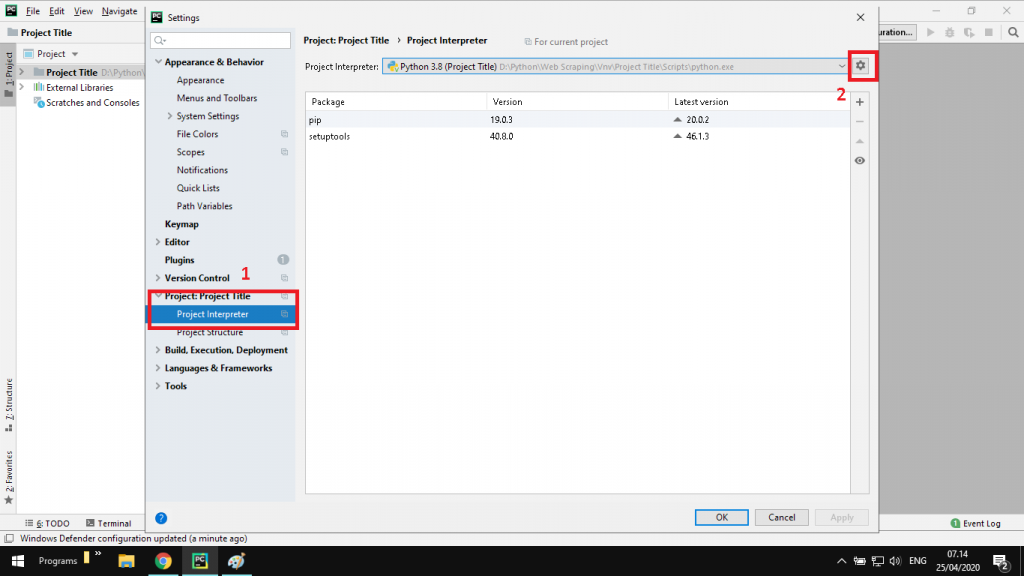
Step 6: Set the directory and name the virtual environment. Here, the virtual environment name is “vnv_first” in the “D:\Python\vnv” directory. Then click “Ok”.
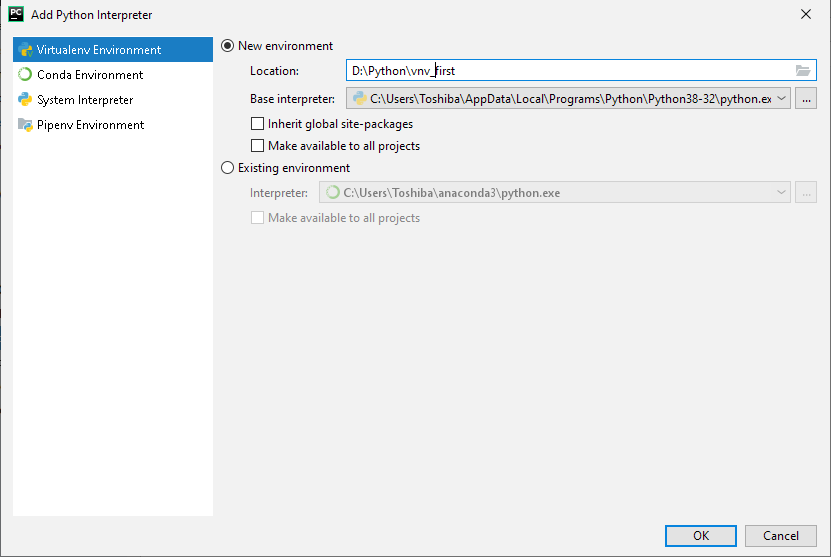
Step 7: Check the virtual environment is ready to use. Just go to Terminal.
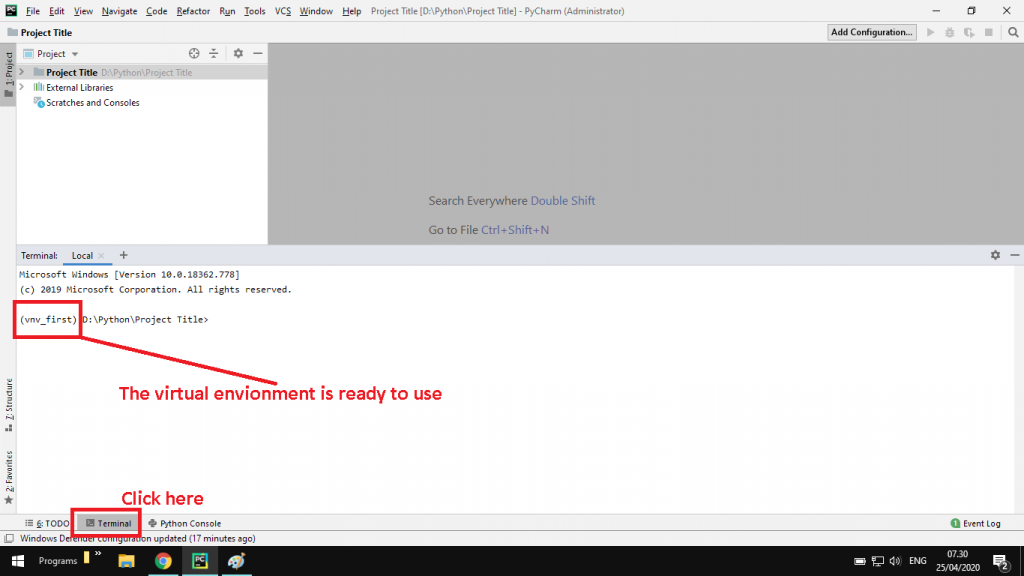
YEAH, Congratulations! Now, you can start to create a new project. Good luck!
Advantages and Disadvantages of Using PyCharm
When it comes to Python development, PyCharm is a sure shot. Though it has a range of advantages, it doesn’t mean that the popular Python IDE is flawless. Therefore, before picking it up, ensure that you ultimately benefit from it. Here are the important feats and flaws of PyCharm to consider:
Advantages
- A plethora of productive shortcuts
- Ability to view the entire Python source code with a single click
- Availability of an array of plugins
- Easy-to-use
- Excellent community support
- Facilitates faster code development
- More powerful, commercial version available
- Straightforward installation process
Disadvantages
- Costly paid version
- May pose issues when trying to fixing tools like venv
- Not suitable for Python beginners
- Resource-intensive application, i.e., requires plenty of memory and storage space
Who Uses PyCharm?
PyCharm serves as the go-to Python IDE for several big names, including:
- Amazon
- Lyft
- Meltwater
- Uploadcare
Competitors of PyCharm
PyCharm is, obviously, not the only efficient Python IDE. There are several others. Each one of them is preferred over the rest by virtue of their respective abilities and features. Top competitors of PyCharm are:
- Cloud9 IDE
- Codenvy
- Eclipse + PyDev
- Komodo IDE
- The Jupyter Notebook
- Wind Python IDE
Conclusion
PyCharm is, undoubtedly, one of the most efficient and powerful IDEs for tackling Python development. The continuously rising popularity of Python ensures that the Python IDE will continue to be developed for the better over time and will attract new Python developers.